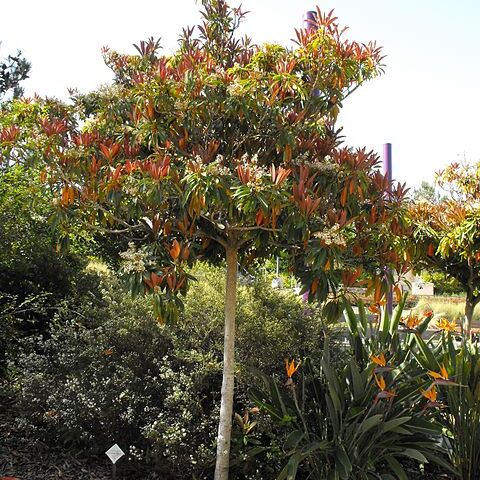Evergreen, unarmed shrubs or small trees; stems spreading, brown-tomentose when young. Lvs usually clustered towards branchlet tips, sessile or short-petiolate, large, simple, serrate or rarely entire; stipules usually small, deciduous. Infl. a terminal, broadly pyramidal panicle, usually tomentose. Fls 5-merous, ☿, small, shortly pedicellate. Hypanthium tubular, closed at apex. Epicalyx 0. Calyx of 5 persistent sepals. Petals suborbicular, spreading to erect, white or cream. Stamens (15)-20-(40). Ovary inferior or semi-inferior; carpels 2-5; styles 2-5, fused at base; ovules paired in each locule. Fr. a moderately-sized to large fleshy pome, ovoid to ellipsoid or globular, with persistent calyx lobes; carpel walls leathery; seeds 1-few, large.
Unarmed trees or shrubs, evergreen. Leaves simple, margin dentate or entire, main nerves terminating in the margin. Stipules free or intrapetiolarly connate. Inflorescence a terminal, compound raceme. Flowers bisexual, 5-merous. Hypanthium obconoid, elongated above the ovary. Sepals persistent. Petals clawed, white. Stamens 15-40. Ovary semi-inferior to inferior, the hairy top of the connate carpels free from the hypanthium, 2-5-celled, styles as many as cells, usually connate at base, ovules 2 per cell. Fruit a pome, crowned by the persistent sepals, mesocarp fleshy or with many stone-cells, endocarp s free from each other, membranous, each containing one seed. Seeds large, testa thin but hard, endosperm absent, embryo with thick cotyledons.
Trees or shrubs, evergreen. Leaves simple; stipulate, usually petiolate, venation craspedodromous or camptodromous, margin serrate or entire. Inflorescences terminal panicles, numerous flowered. Hypanthium cupular or obconical. Sepals 5, persistent. Petals 5, white or yellow, obovate or orbicular, base clawed. Stamens 20. Ovary inferior, 2–5-loculed, with 2 ovules per locule; styles 2–5, connate at base and often pubescent. Fruit a pome with persistent incurved sepals, fleshy or dry, endocarp (core) membranous, with 1 or 2 large seeds.

